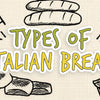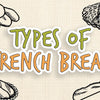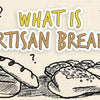Types of Italian Bread: 15 Varieties
When you think of Italian bread probably the first thing that comes to mind is pizza; after all the original pizza was a thin Italian bread which somehow transformed into the savory dish we know of. Italy has had quite a history, especially with wheat bread; ancient Rome developed the first commercial wheat mills in Europe. Rome even opened its first baking school by 1st AD. This would lay the foundation for the baking culture, whereby, villages would have communal bakeries.
These communal bakeries perfected exquisite recipes over time, whereby regions would have their own unique flavor that stuck around into the modern age. This diversity led to a full range of Italian breads that are currently available on the market.
However, some things never change or at least have held true to the test of time such as the Italian love for bread with every meal and not just any type of bread; soft and moist bread with an eye-catching crust.
1. Ciabatta

Recipe: (link)
How to Enjoy: (link)
Taste and Texture: Rusty flavor with a crispy but chewy crumb.
Best Served: The bread is commonly served as an appetizer alongside flavored oil dips such as extra virgin olive oil. Ciabatta’s shape also makes it perfect for preparing sandwiches and paninis. Simply toast your ciabatta slices and spread mayonnaise, add lettuce leaves, tomato slices, and a beef burger.
Additional Information:
Ciabatta is a popular Italian white bread with a slipper shape that was created back in 1982 by a baker in Verona. Popular legend has it that this bread was created as a response to the increased popularity of French baguettes across Europe. Ciabatta has a rather simple recipe with only wheat flour, olive oil, yeast, and water as the primary ingredients.
Its broad, flat, and elongated shape allows the crust to develop freely with a crispy golden texture. The bread is slightly sour due to the fermentation of sugars by the yeast, giving it a more pronounced rustic flavor.
Image from @bakerbossrich Instagram
2. Cecìna (or Farinata)

Recipe: (link)
How to Enjoy: (link)
Taste and Texture: Crispy and crunchy with a hint of spice.
Best Served: This bread is best eaten while still hot and will go down well with a side of sliced sausage and onion. You can also snack on Cecìna without the need for extra dishes.
Additional Information:
Cecìna is an Italian pie that’s prepared with chickpea flour, water, extra virgin olive oil, and salt. This recipe, however, is highly modified across various regions whereby onions, sausage, anchovies, and even black pepper may be added. Cecìna preparation process is quite time-consuming as it requires blending the chickpea flour with water and letting it settle for at least 12 hours before mixing in the extra virgin olive oil and baking the dough in a hot oven.
The end result is a gourmet perfection with a golden crisp crust. The pie is rather thin measuring just about 1 inch thick, so the interior is also crispy but with a slightly chewy texture. The overall taste is determined by the seasoning of choice whereby rosemary and black pepper are used to season each crisp pancake.
Image from @raffaella_semeraro Instagram
3. Coppia Ferrarese IGP

Recipe: (link)
How to Enjoy: (link)
Taste and Texture: Slightly sour with a fluffy crumb.
Best Served: This bread is best consumed with charcuterie or Zia Ferrarese. If you are in a hurry, you can also simply dip the bread in olive oil and a pinch of salt.
Additional Information:
Meet the Coppia Ferrarese the one bread that seems to have achieved artistic perfection. Coppia consists of two sausage-like rolls of dough intercrossing to make an X shape with each roll having a twisted design. While the horns are slightly crusty the center as a soft but dense crumb. The whole bread has a golden hue with blond streaks along with the twisted horns.
The preparation of this bread requires patience and some form of artistic expertise to mix the ingredients, which include wheat flour, extra virgin olive oil, salt, and lard. The dough is then kneaded until it becomes hard to allow twisting and shaping. The baking process results in a compact core with a delicious and savory flavor.
Coppia Ferrarese should be consumed after baking to avoid loss of flavor and consistency. The ears especially will become chewy after a day while the center can be preserved in a bread basket and remain fresh for another 3 to 4 days.
Image from @il_forno_di_bazzani Instagram
4. Piadina

Recipe: (link)
How to Enjoy: (link)
Taste and Texture: Sweet with a soft interior but a crisp crust.
Best Served: If you are looking for the perfect Italian lunch on the go then look no further; fold a piadina into 2 equal halves, fill it up with cold cuts (Italian ham and prosciutto), tomatoes, fresh mozzarella, and greens. Fold up the halves and grill until the ingredients are toasty.
Additional Information:
Piadina is a thin flatbread originally from Apennines area of Italy. Like most other flatbreads the piadina has a simple recipe consisting of flour, olive oil, salt, and water. Some variations use lard instead of olive oil, but the overall outcome is always the same; a delicious crispbread with a soft interior. Traditionally a terracotta dish was used for cooking the bread, but nowadays flat pans and electric griddles will do the same job just fine.
Image from @pranzoitaliano Instagram
5. Colomba Pasquale

Recipe: (link)
How to Enjoy: (link)
Taste and Texture: Sweet with a dense but soft interior.
Best Served: This bread is best consumed as a dessert or over a cup of tea.
Additional Information:
Meet Colomba Pasquale which literally translates to ‘Easter dove’. This is due to its dove-like shape, which is achieved by attaching two halves at the center in a crisscross design. This dessert cake is prepared using Manitoba flour, eggs, water, milk, butter, and sea salt. This is the original Tuscany recipe, but over the years more variations have popped up that require more ingredients such as candied orange or citron, brewer’s yeast, and white caster sugar.
The baker’s topping of choice determines the crust on this bread. Some of the most popular variations include chocolate, dried fruits, and citrus peel. The flavor and aroma can also be changed by using either of the following: Marsala wine, lemon zest, orange zest, and vanilla bean with seeds.
Image from @chiarapassion Instagram
6. Penia

Recipe: (link)
How to Enjoy: (link)
Taste and Texture: Soft crust with a sweet flavor.
Best Served: Due to its soft nature and mounds of sugar, this bread is best eaten alone as a snack or dessert.
Additional Information:
If you have a sweet tooth, then you will love penia. This was traditionally made at Easter time in central Italy, but it has become a common sight in many bakeries. The loaf has a round shape with a small hole in the middle just like a bagel, but its size is slightly larger. The main ingredients include eggs, sugar, butter, yeast, lemon extract, anise seed and extract, and wheat flour.
This combination gives the bread a golden yellow crust with a soft interior with a spongy texture. After baking and allowing it to cool its common practice to apply a glaze of confectioner’s sugar mixed with water. The loaf is then generously covered with colorful sprinkles.
Image from @letseatcakeblog Instagram
7. Pane Carasau

Recipe: (link)
How to Enjoy: (link)
Taste and Texture: Crispy with a salty flavor.
Best Served: Some of the best pane carasau combos include civraxiu which relies on dipping the slices in milk for piety, su mazzamurru which involves covering the bread with pecorino cheese and tomato, and finally pane frattau a combination of tomato soup, meat, eggs, and pecorino cheese.
Additional Information:
Pane carasau is a classic flatbread originally from Sardegna. This sacred Sardinian bread redefines the fundamentals of bread art. While its preparation process relies on flour, baking powder, sea salt, and water, the end result is incredible. This is attributed to the two-stage rising process whereby the thin sheets of dough are baked partially and allowed to rise and separate into 2 crusts before final baking.
The second baking allows the separated sheets to develop a deep gold characteristic color and delicious crispiness. Surprisingly even after undergoing a dual baking process, the bread still retains its flexibility. This comes in handy, especially when deciding on how to eat the bread as you can then roll it up with other ingredients without having to worry about it breaking apart.
Image from @sardegna_illife Instagram
8. Pandoro

Recipe: (link)
How to Enjoy: (link)
Taste and Texture: Sweet with a vanilla flavor and a fluffy light texture.
Best Served: At Christmas as a dessert, but that shouldn’t prevent you from enjoying a piece of sweetness over morning coffee.
Additional information:
Pandoro may as well be the ultimate Christmas cake; from the golden hue with a snow-white powdered sugar topping to the Christmas tree design. This Italian food originates from Verona.
To achieve that fluffy yet somehow dense interior, the bread is prepared using active baker’s yeast, egg yolks, all-purpose flour, granulated sugar, unsalted butter, lemon zest, vanilla extract, cream, and powdered sugar.
Over the years variations of the classic pandoro have been popularized all across Italy from the extra dark chocolate to candied fruits and even a gluten-free version.
Image from @aroundtheink Instagram
9. Pane Casareccio di Genzano IGP

Recipe: (link)
How to Enjoy: (link)
Taste and Texture: Cereal scent with a soft and glazed crumb.
Best Served: Just like other soft crumb bread varieties, the Pane Casareccio di Genzano has a spongy interior riddled with holes making it perfect for soaking up soups and sauces.
Additional Information:
Pane Casareccio di Genzano is one of the few remaining traditional loaves of bread that trace their roots to the Roman empire. The bread is actually classified as a protected geographical indication (hence the IGP, standing for Indicazione Geografica Protetta). The most distinctive part of this bread would have to be its crumb; with an ivory-white hue crowned by a dark-colored crust. Pane Casareccio di Genzano gives off a fragrance reminiscent of granaries and whole cereals.
The bread is prepared using flour, instant yeast, sea salt, water, and unprocessed bran, which is sprinkled on top of the shaped dough before baking. The baking process gives a savory flavor while the controlled temperature allows it to retain a moisture content not exceeding 33%.
Image from @the_romano_baker Instagram
10. Grissini

Recipe: (link)
How to Enjoy: (link)
Taste and Texture: Crispy with an olive oil flavor.
Best Enjoyed: In North America, grissini is often topped with garlic, butter, and cheese while serving it as an appetizer. The bread can also be served as a dessert by topping it with icing and cinnamon sugar.
Additional Information:
Grissini, also known as breadsticks, refers to pencil-sized sticks of bread that have been baked to a dry, crispy texture. Grissini is said to have originated from the Piedmont region of Italy and was intended to be an easy to digest meal for those with digestive problems. In many Italian restaurants, grissini is offered as an appetizer. Over the years variations have popped up, some are thicker than the original pencil size others combine extra ingredients such as prosciutto.
The preparation process involves mixing whole wheat flour, water, honey, active dry yeast, extra virgin oil, and salt. The dough is then rolled into thin sticks and coated with sesame seeds or poppy seeds.
Image from @rominacucina Instagram
11. Donzelle

Recipe: (link)
How to Enjoy: (link)
Taste and Texture: Sweet with a soft texture.
Best Served: This bread is best consumed as part of an antipasto and should ideally be served soon after deep frying to avoid loss of flavor and shape. Alternatively, you can eat them with a cheese board.
Additional Information:
Donzelle is a small rectangular shaped pillow like bread. Originally from the rural Tuscany area of Italy, these puffy loaves have a distinctive pizza-like flavor due to the similarity in ingredients. Donzelle is prepared using sugar, salt, fresh yeast, olive oil, and wheat flour. The dough is then sliced into small rectangular pieces and dipped into boiling oil. The pieces soon puff up and float and it is recommended to turn them over to allow the sides to cook evenly. Some artist bakers may prefer to shape them differently so don’t be surprised if you run into pencil-like donzelle.
Image from @denisa_chedea Instagram
12. Schiacciata

Recipe: (link)
How to Enjoy: (link)
Taste and Texture: Crispy with a salty flavor.
Best Served: This bread is best eaten with cold cuts or filled with cured meat. Alternatively, you can dunk it in a stew or soup.
Additional Information:
Schiacciata is a Tuscany flatbread made with yeast, wheat flour, water, olive oil, and salt. The bread has a brownish hue with a crunchy crust. While the salt is still noticeable, it is kept often in low contrast to the spicy tastes associated with accompanying dishes such as cured meats.
Traditionally schiacciata was flavored with rosemary and would often be brushed down with a mixture of sea salt and olive oil. Sourdough leavening is also common, especially for the Tuscan traditional schiacciata bread. Some bakers prefer to manually flatten the bread by squashing and stretching it halfway through the baking cycle.
Image from @la_sanducherie Instagram
13. Focaccia

Recipe: (link)
How to Enjoy: (link)
Taste and Texture: Rich rosemary taste with a crispy crust.
Best Served: This bread can be eaten alone, as a sandwich bread or as a side topping to meat-based meals. Others prefer to dunk it in soup and sauces; really there’s no limitation in terms of how to eat these wedges of sweetness.
Additional information:
From ancient Rome comes panis focaccia, a flatbread that was baked on the hearth. Fast forward 2000 years later and the Italians are still baking this pizza like bread, albeit the recipe has been refined over time. The modern focaccia is prepared using water, sugar or honey, active dry yeast, all-purpose flour, extra virgin oil, flaked sea salt, and fresh rosemary. The result is a soft golden-brown bread with a rich aroma.
Image by @cookpad_za Instagram
14. Panettone

Recipe: (link)
How to Enjoy: (link)
Taste and Texture: Sweet with a fluffy crumb.
Best Served: Panettone is treated as a dessert due to its softness and sweetness and should, therefore, be consumed as such.
Additional Information:
When it comes to sweet bread, the Italians clearly have the upper hand compared to the French. Panettone is no exemption to this, with a fluffy crumb and an almost citrus-like sweetness. The bread is regarded as a Christmas cake, and the majority of the bakers will shape it into a Christmas tree design even with its somewhat large size. The outer crust has a dark brown hue while the inner parts have a distinctive yellowish white color.
To prepare this cake, you will require eggs, sugar, dry yeast, milk, butter, orange zest, lemon zest, vanilla extract, salt, golden raisins, and candied orange peel after molding the bread it's advisable to let it rise a second time before baking.
Image from @thisisfromroy Instagram
15. Taralli

Recipe: (link)
How to Enjoy: (link)
Taste and Texture: Sweet-savory with a crusty cracker texture.
Best Served: Taralli can be served with a sweet dessert wine or simply snack on them.
Additional Information:
Taralli isn’t really a bread even though it shares a similar recipe with the classic white bread. These toroidal snack foods originated from the Italian peninsula. With a texture close to that of a breadstick and a sweet and savory flavor, they are hard to miss. Sweet taralli are glazed with sugar while the savory variety gets onion, garlic or chili flavor.
The main ingredients in this meal are wheat flour, olive flour, fennel seeds, salt, black pepper, yeast, and water. The dough is cut into small pieces which are briefly boiled in water just like bagels before the baking process. Fried taralli should be eaten immediately as they can not be kept for future use without going bad.
Image from @tarallipuglia Instagram







